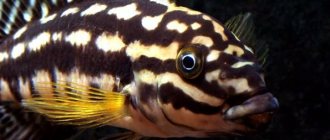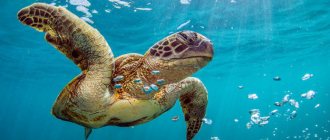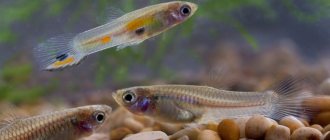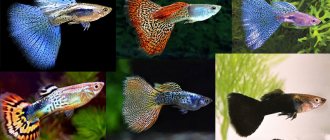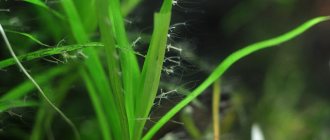Semi-black purple guppy
With a semi-black body and dark purple tails and fins, this species of guppy is another exquisite example of what selective breeding can achieve in guppies.
Semi-black pastel Guppy
The non-black parts of pastel guppy fish can be any pastel color except yellow. The tail fin of these fish is usually pastel white.
Solid color guppies
These guppies can be blue, yellow, red, or even black in color, and they are characterized by having one solid color on both their body and fins.
Bicolor guppies
Bi-colored guppies have a clear base color, which can be red, green or blue, or any other color that does not fit into the previous color categories. The second color makes up at least 25% of their tail color
Multicolored guppies
Multi-colored guppies have at least three color variants, with all colors having an equal distribution in the tail.
Metal guppies
Metallic guppies have the unique ability to hide from predators thanks to iridophore pigment, which allows them to change colors to mimic their environment.
Koi Guppy
Koi guppies resemble the color scheme of koi fish. They have red tails, a white body and a red face. These features can sometimes be found even in female fish.
Panda Guppy
Male Panda guppies are more likely to swim in groups than regular (other species) guppies. Often a group of three fish is formed, accompanied by one male. In large groups of more than 10 males behave more cheerfully and actively. In large groups, Pandas can split into subgroups and then life takes on a different meaning for them. Females recognize their own and “strangers”; they see individuality in each of them. When a male does not belong to a subgroup, he acts “strangely” while flirting with and courting one of the females, and other males, noticing this, begin to pursue the intruder in order to stop his attempt to enter their domain.
To attract females, males turn towards them in such a position that their glossy and bright sides shine in the light in front of the females. Males often like to approach females from behind, especially while they are searching for food.
Jaravi Lapis Guppy
Named after the aquamarine blue color of the lapis lazuli gemstone, this guppy strain has a blue head and is similar to the Japanese blue guppy. The extra color gene on its Y chromosome is what gives this guppy the blue color of its head.
Moscow Guppies
Moscow guppies are a group of breeding forms of the common guppy (Poecilia reticulata). Surprisingly, domestic and Western breeders call different color forms of guppies “Moscow”. For the former, these are red varieties with a well-developed veil tail, for the latter, fish with a dark blue, uniform body color. A similar confusion occurred at one of the international guppy exhibitions, when the victory was awarded to dark blue fish from the collection of Japanese breeders, who in the description indicated the place of purchase of the producers - Moscow. Unfortunately, due to the lack of a unified classification of guppy breeds, the organizers did not know that the name “Moscow” was already borne by another color variation.
Platinum Guppy
In nature, the body length of guuppies usually does not exceed 6 cm. Breeders have bred guppies with a body length of about 8 cm. Females and males differ greatly from each other in size, shape and color.
Females
Female platinum red tail guppies (Guppy platinum Red Tail) are much larger than males, their body length averages 5.5–6 cm (maximum 8 cm), the abdomen is rounded, inconspicuously colored, usually gray, brownish or olive, near the anus the holes are a large dark spot. The fins of females of the original (wild) form and of most purebred representatives are round and transparent. Breed groups have been bred in which the females have a brightly colored body, with decorations on the fins in the form of specks of black, yellow and reddish colors.
Males
Male platinum red-tail guppies (Guppy platinum Red Tail) on average do not exceed 3 cm in length, they have a small, narrow body, brightly colored in the back with a pattern of spots of various shapes and colors, moving to the caudal fin.
- In nature, several color variations of male guppies are known. In males from the Venezuelan population, the body color is predominantly green, in Barbadian males the color is red-black, in Trinidadian males it is golden-green, blue, and violet. Currently, through the efforts of breeders, a wide variety of forms of male guppies have been developed. They vary greatly in size and shape of the caudal fin and coloring. From wild species of guppies, the males of which have a small rounded fin, breeds have been bred that have a ribbon-shaped, fan-shaped, sword-shaped, lyre-shaped, trailed, awl-shaped and other forms of caudal fin. The size of the caudal fin of males of some breeds exceeds the length of the body of the fish itself. The dorsal fin is also varied in shape. It can be round, triangular, rectangular, ribbon-shaped.
- One of the reasons for the great popularity of guppies is the ability of this South American fish to live in a wide variety of conditions. Guppy is the most unpretentious of aquarium fish. A pair of guppies can be content with an aquarium volume of 1.5–2 liters; a male needs 0.5 liters of water, and a female needs about one liter. For large breeds of guppies and breeds with veil tails, aquariums should be two to three times larger. Usually an aquarium with 1–1.5 liters of water per male and 2–3 liters per female is sufficient for them. The optimal water level for guppies is 35–40 cm. To prevent the fish from jumping out of the water, the aquarium is not filled to the brim, leaving 5–6 cm free, and the top of the aquarium is covered with a cover glass. The length of the aquarium for breeding forms of guppy must be at least 40 cm.
Dragon Head Guppy
This type of guppy lives up to its name, having an interesting color scheme and tail pattern. The tail and dorsal fins show brighter red-orange colors, while the fish's body is dark in color all the way to its midsection, where it becomes lighter in color.
Type of guppy based on eye color
Guppies with red eyes
This species of guppies is very rare and they tend to be quite small. However, their eyes have a bright red, red-orange color that is easily noticeable.
Red-eyed Albino Guppy
Albino fish lack the melanin pigment in their eyes, which explains the reddish tint to the color they end up having.
Maintenance and care
They are distinguished by good endurance and unpretentiousness to the environment. Successful long-term maintenance depends on the correct choice of neighbors, regular feeding and timely maintenance of the aquarium. The latter includes the prevention of installed equipment and the weekly replacement of part of the water with fresh water, which is usually combined with the removal of organic waste (remains of feed, excrement) using a siphon. The newly added water should have a similar temperature, and the hydrochemical composition will not play a significant role.
Our product Aqvium natural dry food for small and medium fish from clean lakes of Siberia and Northern Crimea in environmentally friendly biodegradable packaging.
Find out more
It is worth remembering that any artificially bred breed can interbreed with other strains and produce hybrid offspring. Considering the rate of reproduction of guppies, there is a high probability of degeneration if they are in the company of other varieties.
Types of guppies based on pectoral fins
Guppy Dumbo (Elephant Ears)
Dumbo guppy (Elephant ears) is a breeding form of the common guppy (Poecilia reticulata), the distinctive feature of which is its highly developed pectoral fins. From the outside, they really resemble the large ears of an elephant, which is why the fish was named after the famous cartoon character
Otherwise, these are the same easy-to-care and maintain fish. They are an excellent choice for beginner aquarists. Dumbo guppies are not only hardy and beautiful, but also easy to breed at home, because they are viviparous. This means that Dumbo do not lay eggs, as most fish species do, but instead give birth to fully formed fry.
Main types
Today there are more than 200 varieties of this aquarium inhabitant. These are mainly selective, artificial species.
There are several classifications of guppies. Their Latin names use the following designations:
- the letter N means that the species belongs to wild individuals;
- P - similar to the natural type;
- K - obtained by crossing, usually with other viviparous animals.
Tail shape
One of the classifications divides species according to the shape of the tail.
| Variety name | Description |
| Round-tailed | The dorsal and caudal fins are large, rounded, often fused. |
| Flagtails | Both the tail and the dorsal fin resemble a flag with rounded corners. The plumage is large in size and raised high. |
| Spinetails | The caudal fin, wide at the base, greatly elongates and narrows almost into a needle. On the back the plumage is raised high. |
| Speartails | These fish are also called shovel-tailed fish because of the peculiar shape of the tail feathers. On the back, the fin stands high and is most often connected to the tail. |
| Horseshoe crabs | This variety, in turn, is divided into carriers of a single upper or lower sword and a double sword. |
| Fantails | This is a particularly beautiful variety with plumage in the form of a lush fan or skirt. |
| Lyrebirds | The caudal fin is large and voluminous and resembles a lyre, and the dorsal fin is raised high and connects to the lower plumage. |
Color
The following color classification is accepted among aquarists.
| Breed name | Description |
| Natural - Endler's guppy | In its natural habitat, the color of the fish’s coat is gray and all its shades. |
| Black Prince | Males have a bright graphite color, females are slightly paler, with gray tints. |
| Moscow | Males are bright turquoise with a blue or azure tint, females are gray in color with dense black fins. |
| Red guppies | The colors of this breed are varied, all shades of scarlet with a pearlescent tint in males. Females are paler, but also colored red. |
| Leopard | Very bright and beautiful males of this species have topaz spots on their black body, and only graphite fins. In females, markings are also located along the plumage. |
| Spanish | The body of the fish is black or dark blue with a pearlescent tint, and the plumage is bright red or orange. |
| Yellow | Males are colored in all shades of yellow, and the peritoneum is much lighter, almost white. This color predominates in females, and there is a minimum of topaz colors on them. |
| Red/green cobra | The yellow or green body of these fish has a bright orange pattern, reminiscent of the skin of a snake. More often this variety is called the “red dragon”. |
| Mix | The result of crossing different varieties has an incredible color, in which a dozen different colors are mixed. |
| Neon | The body color of these fish is very delicate, sky-blue, slightly luminous. |
| Japanese | This dwarf breed can come in different colors, but they are predominantly fish in bright colors - scarlet, graphite, dark blue. The whole body resembles a small patchwork quilt. |
| Canadian | The body near the head is a natural grayish hue, but the back half is gradually darker, turning into an almost black light at the base of the fin. The plumage is lush and almost white. |
Where to buy guppies, their price
You can purchase guppies of any age and color either at a pet store or from numerous private breeders. When purchasing an aquarium fish such as a guppy, it is very important to take into account the optimal ratio of the number of males and females, which should be one to two.
The cost depends on size, age, breed characteristics. For example, male wild Endler guppies P. wingei cost approximately 100-110 rubles, and Japanese blue sword guppies P. recticulata are sold at a price of 90-95 rubles . Particularly popular in our country are “Blondie-black” guppies P. recticulata and German yellow ones, the price of which starts from 90-95 rubles . As a rule, even quite rare species are quite affordable.
How not to buy sick fish?
When purchasing new inhabitants for your aquarium, pay attention to their appearance and behavior.
Healthy fish should:
- have shiny, bright eyes. In sick fish they are cloudy and whitish;
- when you see a person, swim to the front window, and not hide in the corners;
- swim through all levels of the aquarium, do not make chaotic, erratic movements.
If you notice white spots, bumps, or frayed fins on at least one of the fish for sale, you should not buy even healthy-looking fish from this aquarium. They may be infected with the same disease. If you doubt that the fish are healthy, do not make a purchase.
After purchasing fish, in order to avoid infecting the old-timers, newcomers must be kept in a separate aquarium for a week or two.
Video
How to distinguish between males and females
Guppy owners have no problems determining the sex of their pets. Males are distinguished by a more slender body, they have an impressively sized caudal fin, and the anal fin has become a gonopodium - the organ with which the male fertilizes the female.
Females are larger fish, with a large, noticeable abdomen, and their color is not as bright as that of males. Even among the young animals, “boys” can be distinguished; they begin to acquire color earlier than the rest.
Keeping black guppies
No matter what you hear about the endurance of guuppies, take time and read the simple rules that must be followed for a full life for a mute pet.
The volume of the aquarium for a small flock is from 40 liters. As decoration, you can use any primer that is contrasting with black, i.e. almost anyone!
The presence of live plants is welcome, but don’t get too carried away! Give the fish room to swim freely.
A filter in an aquarium will significantly improve the quality of life of its inhabitants.
Equip the aquarium with a filter and aerator, as well as lighting fixtures - this will help you avoid many troubles, including serious guppy diseases . Do a partial water change at least once a week. Required water parameters: temperature 20-27 degrees, hardness dGH from 10, acidity pH 6-8.
At low temperatures, guppies of any breed will grow larger than usual and live longer, but this can have a detrimental effect on their health.
general characteristics
The natural habitat of guppies is the United States, as well as South America, the Dominican Republic, Cuba and other island countries in Central America. They live in small freshwater bodies of water, lagoons and estuaries. These are schooling fish that live for about 3-4 years.
By their nature, they are not as colorful as their domestic “brothers”. But they differ in larger size. Males are small, 1.5-4 cm in length. Females can grow up to 7 cm. In aquarium conditions, these individuals are slightly smaller, but have a variety of colors.
Endler's guppy: female and male
Males differ significantly. They have an anal fin. They are slimmer and have a beautiful tail, which can have a wide variety of colors. Females are not as expressive. They do not have such beauty, they are larger and, as a rule, do not have such bright colors.
Who do guppies get along with?
These small fish are peace-loving, non-conflicting and do not bother their neighbors. But they themselves can be a target for attacks by larger and more aggressive individuals. It should be borne in mind that their predatory counterparts will always consider these babies only as food. The following breeds fall into this category:
- mosquerot,
- giant gourami,
- pangasius,
- shark ball.
Read also: Platydoras striped
In addition, you should not place active and mischievous fish in the same aquarium with guppies, which amuse themselves by cutting off the fins of other inhabitants. This is the sin:
- barbs – Sumatran, Denison, fiery,
- kissing gourami,
- thorns.
An excellent company for these nimble little fish will be the same inhabitants - peaceful, positive, modest in size:
- rasbory,
- cardinals,
- congo,
- neons,
- cherry barbs.
Almost all small catfish coexist well with guppies, for example, speckled, common, and corydoras. They are real orderlies of reservoirs, cleaning the soil from waste. But larger catfish are predators, which means they are not suitable as neighbors for gupeshkas. The exception is the common hoplosternum - with a length of 13-15 cm, they are quite peaceful and harmless aquarium inhabitants.
Living in the natural environment
The fish breed got its name thanks to its discoverer, Robert Guppy. He was the first to discover these small, nimble fish on the island of Trinidad in 1866, and studied and described them. The guppies' habitat is quite extensive; they can be found on the islands of Trinidad and Tobago, as well as in some areas of South America, washed by the Caribbean Sea and the Atlantic Ocean.
The fish prefer to live in clean, clear waters, but also take root well in coastal areas with brackish water. However, they are not suited to the salty marine environment. “Gupeshkas” have a good appetite; they eat worms, larvae, bloodworms and various small insects.
Due to the peculiarities of their diet, these fish are welcome in many areas. They began to be settled in reservoirs where malarial mosquitoes bred en masse, since guppies feed on their larvae. Naturally, this expanded the habitat of these underwater inhabitants.
Male wild guppies are brighter in color than females, but even they are inferior in color intensity to the selected forms of the breed. In nature, bright color has a protective function; it should scare away predators from these small, defenseless inhabitants.
Nutrition
Omnivorous guppies happily consume both plant and animal foods, so your task is to make their diet balanced. To do this, use the following fish in food: rotifers, asplanchus, cyclops, daphnia, mosquito larvae, coretra, bloodworms; chlorella, spirulina. And the fish themselves will add some algae to their diet. Although guppies tolerate dry food well, you should not overdo it.
It is enough to feed adult fish 1 – 2 times a day. Like all aquarium fish, gupeshkas are prone to obesity, as a result of which they lose the ability to reproduce and get sick. Therefore, it is better to underfeed guppies than to overfeed them. For adult fish, it is necessary to arrange 1 - 2 fasting days (without food) per week.



